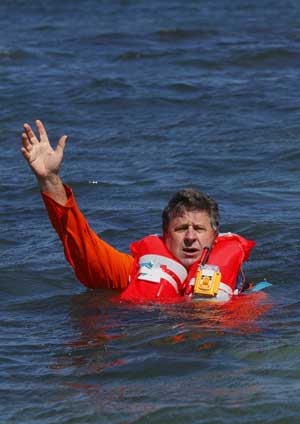
Mobilarm has announced that it has secured a significant new contract to supply its VHF Locator Beacons to Bristow Helicopters Australia (part of the Bristow Group) as the sole contractor to BHP Billiton Petroleum for offshore personnel transfers by helicopter in Australia. In the initial order, Mobilarm will supply 50 of its innovative V100 VHF beacons for integration into the RFD Beaufort MK28 lifejackets to be worn by all BHP Billiton Petroleum personnel during transfers to offshore platforms in the Western Australian North West region.
In many European countries, including the United Kingdom, the use of Personal Locator Beacons (PLB) is mandatory for all offshore helicopter transfers, with approximately 5,000 PLBs in use throughout the offshore oil and gas industry per day. Although mandatory use is not stipulated in Australia, BHP is keen to ensure the highest standards of safety are achieved and has become the first Australian company to insist on the use of marine-based PLBs for its employees transferring to offshore platforms by helicopter.
The Mobilarm beacon purchase comes as a result of a major test of emergency response systems conducted by BHP Petroleum off Exmouth, Western Australia earlier this year as reported in the National Offshore Petroleum Safety Authority (NOPSA) September newsletter. The two emergency response exercises, both involving offshore helicopter-based scenarios, were designed to test various aspects of the Operator's emergency response and marine capability including recovery and response times and the use of PLB technology.
The goal of both scenarios was to test response times against the Operator's Search and Rescue Performance Standards and to assess the search and rescue competencies of participants, equipment, systems and processes. Subsequent to the exercise, an Australian Petroleum Production & Exploration Association (APPEA) Search and Rescue Working Group has been formed to investigate a consortium approach with other Exmouth Sub-basin Operators, furthering the establishment of a standby emergency rescue and recovery vessel and opportunities for mutual support in emergency events.
"BHP's initiative to implement marine based PLBs represents a significant development in personnel safety for offshore helicopter transfers in Australia," comments Lindsay Lyon, CEO of the Perth, Western Australia based Mobilarm. "While the aircraft is legally required to carry 406 MHz Emergency Locator Transponders (ELT), like 406 MHz EPIRBs, these devices only provide the location of the downed aircraft, not the individual escaped personnel. The significant advantage of the Mobilarm V100 VHF Locator Beacon over ELT and EPIRBs is its unique ability to alert local rescue assets directly and provide those already closest to the incident with the location and tracking data of each and every crash survivor."
The Mobilarm V100 is an adaptable Maritime Survivor Locating Device. The pocket-sized unit can be attached to clothing or seamlessly integrated into lifejackets to provide individual alerting capability in a man overboard event. The device is automatically water-activated if the wearer falls overboard, sending out a man overboard distress alert and real time GPS coordinates of the casualty's current position via VHF DSC. The signal is also transmitted in a synthesized voice on VHF channel 16, making recovery by the casualty's parent vessel, Fast Rescue Craft or any other marine assets in the vicinity, extremely efficient. Since the probability of survival at sea is directly related to the length of time in the water, alerting nearby vessels or other marine assets immediately will bring about a faster and more effective rescue.